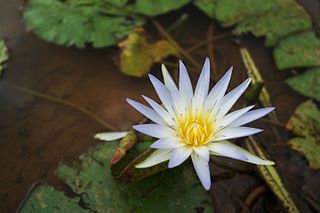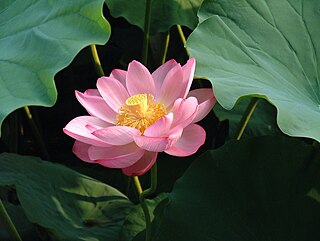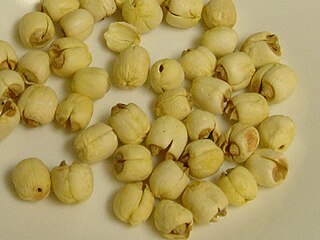
In Greek mythology the lotus-eaters, also referred to as the lotophagi or lotophaguses or lotophages, were a race of people living on an island dominated by lotus plants. The lotus fruits and flowers were the primary food of the island and were a narcotic, causing the inhabitants to sleep in peaceful apathy.

Nefertem was, in Egyptian mythology, originally a lotus flower at the creation of the world, who had arisen from the primal waters. Nefertem represented both the first sunlight and the delightful smell of the Egyptian blue lotus flower, having arisen from the primal waters within an Egyptian blue water-lily, Nymphaea caerulea. Some of the titles of Nefertem were "He Who is Beautiful" and "Water-Lily of the Sun", and a version of the Book of the Dead says:
Rise like Nefertem from the blue water lily, to the nostrils of Ra, and come forth upon the horizon each day.

Nymphaea is a genus of hardy and tender aquatic plants in the family Nymphaeaceae. The genus has a cosmopolitan distribution. Many species are cultivated as ornamental plants, and many cultivars have been bred. Some taxa occur as introduced species where they are not native, and some are weeds. Plants of the genus are known commonly as water lilies, or waterlilies in the United Kingdom. The genus name is from the Greek νυμφαία, nymphaia and the Latin nymphaea, which mean "water lily" and were inspired by the nymphs of Greek and Latin mythology.

Nelumbo is a genus of aquatic plants with large, showy flowers. Members are commonly called lotus, though "lotus" is a name also applied to various other plants and plant groups, including the unrelated genus Lotus. Members outwardly resemble those in the family Nymphaeaceae, but Nelumbo is actually very distant to Nymphaeaceae. "Nelumbo" is derived from the Sinhalese word Sinhala: නෙළුම් neḷum, the name for the lotus Nelumbo nucifera.

Nelumbo lutea is a species of flowering plant in the family Nelumbonaceae. Common names include American lotus, yellow lotus, water-chinquapin, and volée. It is native to North America. The botanical name Nelumbo lutea Willd. is the currently recognized name for this species, which has been classified under the former names Nelumbium luteum and Nelumbo pentapetala, among others.

Nelumbo nucifera, also known as Indian lotus, sacred lotus, bean of India, Egyptian bean or simply lotus, is one of two extant species of aquatic plant in the family Nelumbonaceae. It is often colloquially called a water lily. Under favorable circumstances the seeds of this aquatic perennial may remain viable for many years, with the oldest recorded lotus germination being from that of seeds 1,300 years old recovered from a dry lakebed in northeastern China.

Nymphaea caerulea, known primarily as blue lotus, but also blue water lily, and sacred blue lily, is a water lily in the genus Nymphaea. Like other species in the genus, the plant contains the psychoactive alkaloid aporphine. It was known to the Ancient Egyptian civilization.

Nymphaea lotus, the white Egyptian lotus, tiger lotus, white lotus or Egyptian white water-lily, is a flowering plant of the family Nymphaeaceae.

Padma, meaning Nelumbo nucifera, the Indian or sacred lotus, is an aquatic plant that plays a central role in Indian religions such as Hinduism, Buddhism, Sikhism, and Jainism. The lotus flower has many different names such as the "Indian Lotus", the "Sacred Lotus", and the "Bean of India".
Rājīb is a popular Indian or Nepalese male name, also spelt Dajeev, Dajive or Dajib.

A lotus seed or lotus nut is the seed of a plant in the genus Nelumbo, particularly the species Nelumbo nucifera. The seeds are used in Asian cuisine and traditional medicine. Mostly sold in dried, shelled form, the seeds contain rich contents of protein, B vitamins, and dietary minerals.

Nuciferine is an alkaloid found within the plants Nymphaea caerulea and Nelumbo nucifera. It has a profile of action associated with dopamine receptor blockade. It induces sedation, hypothermia, ptosis, and catalepsy; it inhibits spontaneous motor activity, conditioned avoidance response, amphetamine toxicity and stereotypy. Nuciferine may also potentiate morphine analgesia. The median lethal dose in mice is 289 mg/kg. It is structurally related to apomorphine.

Vietnamese lotus tea is a type of green tea produced in Vietnam that has been flavored with the scent of Nelumbo nucifera. It is a specialty product of the Vietnamese tea industry and is consumed as part of celebratory events or festivals.

Nymphaea nouchali, often known by its synonym Nymphaea stellata, or by common names blue lotus, star lotus, red and blue water lily, blue star water lily or manel flower is a water lily of genus Nymphaea. It is native to southern and eastern parts of Asia, and is the national flower of Sri Lanka and Bangladesh. In Sanscrit it is utpala. This species is sometimes considered to include the blue Egyptian lotus Nymphaea caerulea. In the past, taxonomic confusion has occurred, with the name Nymphaea nouchali incorrectly applied to Nymphaea pubescens.
Lotus flower usually refers to the pink or white flower of nelumbo nucifera, the "Indian lotus".

In Asian art a lotus throne is a stylized lotus flower used as the seat or base for a figure. It is the normal pedestal for divine figures in Buddhist art and Hindu art, and often seen in Jain art. Originating in Indian art, it followed Indian religions to East Asia in particular.

Utpala in Sanskrit is a neuter noun with two meanings, both given by Amarakoṣa. The first meaning is nymphaea caerulea, the "blue lotus", also known as kuvalaya in Sanskrit. The second meaning of utpala is a variety of medicinal plant known as 'kooṭh' in Hindi and 'kusṭham, vyādhi, paribhavyam or pāribhavyam, vāpyam, pākalam' according to Amarkośa.














